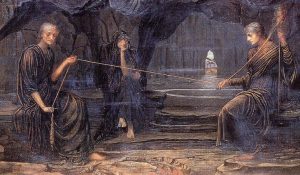I love me some mythological figures.
And these days, myth is a whole lot easier to swallow than reality.
And come on, I know I’m not the only one obsessed with Game of Thrones’ Daenerys Targaryen and her three ill-tempered winged dragons.
The stories of Greek mythology have always fascinated me. From heroes and monsters to flying stallions, I found the creatures unnerving yet beguiling.
But none more than the Fates and the Furies.
THE FATES
I’ll start with the Fates: Three sisters, who determined human destinies and affected the paths of all of the universe. The ultimate girl power.
Clotho (The Spinner), Lachesis (The Allotter) and Atropos (The Inflexible) were goddesses of predetermination, spinners of the thread of life and dealers of some crazy karma.
And if you dared to step out of line and make these ladies mad? They didn’t get mad; they got even. Let’s just say karma was a bitch—times three.
Clotho, the youngest of the Fates spun the thread of destiny. Lachesis measured its allotted length, and when she decided that the thread was long enough, she would give the order to Atropos, the oldest of the sisters, to snip the thread with her shears, cruelly cutting through the cord of life.
In older mythology, the Fates were fatherless and created by the goddess Nyx (Night) without the intervention of man.
Clotho (the present), Lachesis (the future), and Atropos (the past) are almost always depicted as weavers of tapestry on a loom, with the tapestry dictating the destinies of men. The threads often appear incredibly delicate and yet we know that only Atropos’ sharp and menacing shears can cut through them. Her ability to end it all suggests the unforgiving power of karma.
THE FURIES
And then there were the Furies: Three furious and infuriated sisters.
Homer mentioned them in the Iliad as daughters of the night who had no pity in their hearts. And in the Odyssey, he referred to them as the “avenging Furies.”
Alecto, Megaera, and Tisiphone were three powerhouse goddesses who lived in the underworld and exacted vengeance and retribution on wicked men who hurt women and swore false oaths.
The Furies were spawns of earth and sky.
The three daughters were born of Gaia (Mother Earth), who conceived them in the drops of blood from Uranus (Father Heaven) that fell upon her body when he was castrated by his son Cronus with a jagged sickle made of adamant.
Ouch.
Their Latin names translate as follows: Alecto (Unceasing), Megaera (Grudge), and Tisiphone (Retribution).
They were guardians and protectors of the law when the state had not yet intervened or did not exist, or when the offense was a crime of ethics and not actual law.
Their brass wings made escape impossible; their ripping claws made their torment relentless. They would harass and injure their prey but never killed them.
They punished men for crimes against the natural order and were particularly angered by homicide, perjury, and unkind acts against one’s family. The Furies also protected underdogs and social outcasts.
A victim seeking justice could call down the curse of the Furies upon the criminal, the liar, the unethical, and those sisters would get to work.
Now, these are my kind of girls.
Tormentors who pursued unpunished evildoers and relentlessly hounded lying, cheating, unethical men.
The Fates and the Furies: six powerful badass women, who were the embodiment of divine order and law.
We sure could use some avenging and relentless Furies right about now, with a little fateful karma thrown in.

